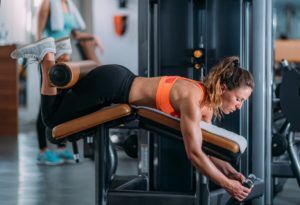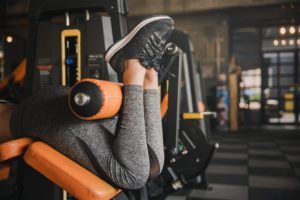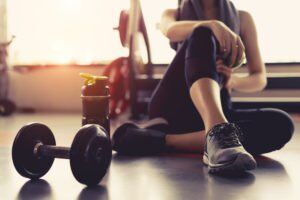
How to Do a Leg Curl
Most people tend to have underperforming or inflexible hamstrings, due to a sedentary lifestyle. Because of this, Romanian deadlifts and other hamstring exercises are often too difficult to do straight away. Leg curls are an important stepping stone to improved hamstrings and are a fantastic exercise. In this article, we will look at how to do a leg curl properly, and why you would want to.
What is a Leg Curl?
The leg curl is a hamstring exercise that involves curling your feet back towards your glutes either while sitting, standing, or lying down. The most common leg curl by far is the seated leg curl machine found in any large gym. But there are also lying leg curl machines, and it can be performed using resistance bands while standing or while using a dumbbell and lying down.
This article will focus on the seated leg curl machine, lying leg curl machine, the standing leg curl, and the leg curl with a dumbbell (another lying leg curl variation).
 What are the Benefits of a Leg Curl?
What are the Benefits of a Leg Curl?
The leg curl is a simple to learn exercise that strengthens the hamstring muscles and can help to increase flexibility. Improving your hamstrings can help to improve performance in other exercises, and it can also help to prevent injury. Runners who spend time strengthening the hamstrings report fewer injuries for example.
Leg curls also make excellent warm up exercises for large compound lifts such as deadlifts or barbell squats. A couple of high rep, low weight sets of seated leg curl will help warm up your hamstrings preparing you better for more challenging leg exercises.
Leg curls can also help to reduce some forms of lower back pain, but not all. Tight hamstrings can affect posture which can then affect your lower back. But always consult your doctor about your lower back before you try and “fix it” in the gym.
Leg Curl Variations
There are four main leg curl variations, two of which require specific resistance machines, one of which requires resistance bands, and one of which requires a bench and a dumbbell.
Seated Leg Curl
The seated leg curl requires a seated leg curl machine. Walk up to the machine and sit down with your lower back flush against the seat. Bring the footpad down so that you can place your feet in it, then extend it so that your feet are straight out in front of you.
Curl your feet backwards using your hamstrings, holding on tightly to the handles and ensuring that your lower back does not arch while you do so. If it does, then the weight is probably too heavy. Pause when your feet are as far back as they can go and squeeze your hamstrings, then slowly return your feet to the starting position. Pause, then repeat the process for another rep.
 Lying Leg Curl
Lying Leg Curl
The lying leg curl requires a lying leg curl machine. Unlike the seated version, this machine requires you to lie down on your front and place your feet underneath a foot pad so that you start in a straight line. You then take a deep breath and curl your feet in a semi circle until they are almost touching your glutes, squeeze the hamstrings, and then return to the starting position.
Standing Leg Curl
The standing leg curl can either be performed using a machine (a seated leg extension can sometimes be used), or it can be performed with a cable machine (using an ankle strap). It is also possible to use a resistance band that is tied to a heavy column (the leg of a power rack for example) and looped around the ankle.
The idea is that you stand upright and then lean forward a bit so that your glutes are sticking out. The resistance should be around the back of your leg (between the ankle and lower part of your calf depending on the machine/resistance band). You need to keep your quads still, and then you curl your foot towards your glutes, just like the other variations. Pause at the top, and then slowly return.
Leg Curl with a Dumbbell
For this exercise you need to lie on your front on an exercise bench with your knees and lower limbs hanging off the end. Then a partner will place the dumbbell between your feet and you use that as the resistance. Curling your feet towards your glutes, pausing, and then returning to the starting position.
This exercise is great as an alternative to the others, particularly if you are in a busy gym. But many people find that the movement is a little tricky, and the tension vanishes once the dumbbell begins to descend.
 Leg Curl Form & Technique Tips
Leg Curl Form & Technique Tips
There are a few tips that apply to all leg curl variations, here are a collection of the best ones:
- Slow it down: Most people perform this exercise as fast as possible, using momentum to grind out as many reps as possible. But this doesn’t really do your hamstrings any favours. You are taking away all of the tension from the movement. While you can perform the curling part quite fast and smoothly, you definitely want to perform the return (eccentric) nice and slowly. This will really strengthen those hamstrings.
- Squeeze the Hamstrings: Once you have curled the weight, it is great to properly squeeze the hamstrings. This will improve the contraction and lead to a better lift. This also helps you to slow the tempo down and removes the opportunity to cheat.
- Watch Your Feet: You can’t literally watch your feet, because they are behind you. But when setting up you want to ensure that your feet are facing straight forward. Turning your feet inwards or outwards can change the angle of the movement and place more emphasis on one side of your hamstrings. While this has some benefits, you don’t want to be doing it too often.
Muscles Worked During a Leg Curl
The leg curl is considered by many to be a hamstring isolation exercise, meaning that it targets the hamstrings and nothing else. There is an argument that the exercise (particularly some variations) will also work the glutes, but not as much as traditional hamstring-glute exercises such as the good morning or Romanian deadlift.


 What are the Benefits of a Leg Curl?
What are the Benefits of a Leg Curl? Lying Leg Curl
Lying Leg Curl Leg Curl Form & Technique Tips
Leg Curl Form & Technique Tips
No Comments yet!